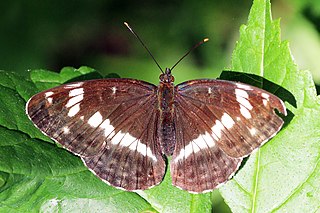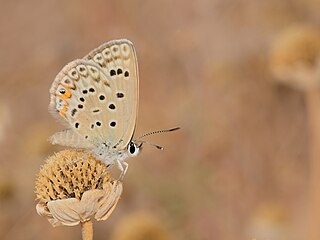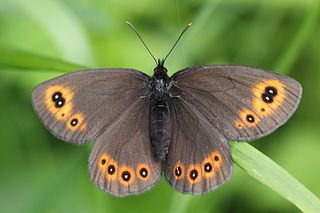
The purple hairstreak is a butterfly in the family Lycaenidae distributed throughout much of Europe, North Africa, Anatolia, Caucasia, and Transcaucasia. The larva feeds on Quercus robur, Quercus petraea, Quercus cerris and Quercus ilex.

The silver-studded blue is a butterfly in the family Lycaenidae. It has bright blue wings rimmed in black with white edges and silver spots on its hindwings, lending it the name of the silver-studded blue. P. argus can be found across Europe and east across the Palearctic, but it is most often studied in the United Kingdom where the species has experienced a severe decline in population due to habitat loss and fragmentation.

The holly blue is a butterfly that belongs to the lycaenids or blues family and is native to the Palearctic.

The grayling or rock grayling is a species in the brush-footed butterfly family Nymphalidae. Although found all over Europe, the grayling mostly inhabits coastal areas, with inland populations declining significantly in recent years. The grayling lives in dry and warm habitats with easy access to the sun, which helps them with body temperature regulation.

Limenitis camilla, the (Eurasian) white admiral, is a butterfly of the family Nymphalidae. It is found in woodland throughout southern Britain and much of Europe and the Palearctic, extending as far east as Japan.

Papilio aegeus, the orchard swallowtail butterfly or large citrus butterfly is a species of butterfly from the family Papilionidae, that is found in eastern Australia and Papua New Guinea.

Parnassius ariadne is a high altitude butterfly which is found in Central Asia. It is a member of the snow Apollo genus (Parnassius) of the swallowtail family (Papilionidae).

Parnassius stubbendorfi is a high-altitude butterfly found in from the Altai Mountains across central, south, and far east Siberia, Sakhalin and the Kuril Islands and from Mongolia across north China to west Korea and Japan (Hokkaido). It is a member of the snow Apollo genus (Parnassius) of the swallowtail family (Papilionidae).

Polyommatus eros, the Eros blue or common meadow blue, is a species of blue butterfly found in the Palearctic.

Plebejidea loewii, the large jewel blue, is a species of blue (Lycaenidae) butterfly.

Zerynthia rumina, the Spanish festoon, is a butterfly belonging to the family Papilionidae. It is a widespread species in Iberia and frequents most habitats.

Erebia medusa, the woodland ringlet, is a member of the subfamily Satyrinae of the family Nymphalidae.

Allancastria is a genus of Palaearctic swallowtail butterflies in the subfamily Parnassiinae. Five species are known. The genus has a complex history.

Allancastria cerisyi, the eastern festoon, is an Old World papilionid butterfly whose geographical range extends from the Balkans to include Turkey and the near Middle East. It exhibits several geographical variants.

Allancastria louristana is a butterfly belonging to the family Papilionidae. It is found only in western Iran.

Polyommatus amandus, the Amanda's blue, is a butterfly of the family Lycaenidae. It is found in the Palearctic realm.

Polyommatus escheri, Escher's blue, is a butterfly of the family Lycaenidae. It is found in Southern Europe and Morocco.

Boloria polaris, the Polaris fritillary, is a butterfly of the family Nymphalidae. It is found in northernmost Scandinavia, North America and in Greenland. It is also found in northeastern Russia and across the Palearctic to Chukotka. It is one of only six butterfly species found on Canada's Ellesmere Island.

Pseudochazara anthelea is a species of butterfly in the family Nymphalidae. It is found in Albania, the Republic of Macedonia, Bulgaria, Greece, Turkey and northern Iraq. The males can be easily distinguished from the females by the white base and they are found in dry, stony slopes and gullies, usually on limestone.

Polyommatus admetus, the anomalous blue, is a butterfly of the family Lycaenidae. It was described by Eugenius Johann Christoph Esper in 1783. It is found in south-eastern Europe and Turkey.






















